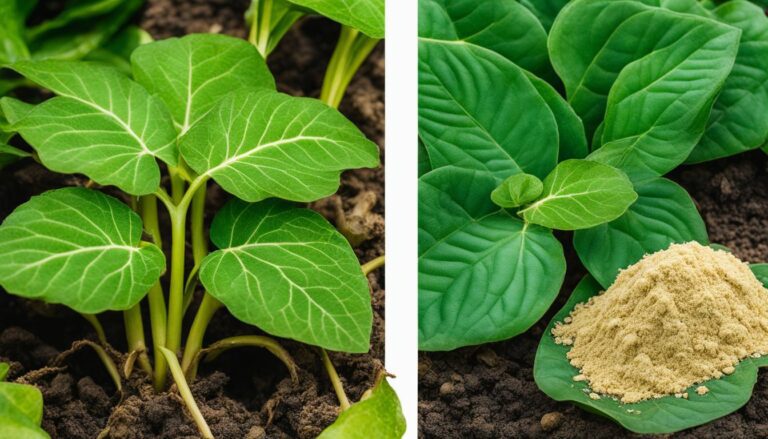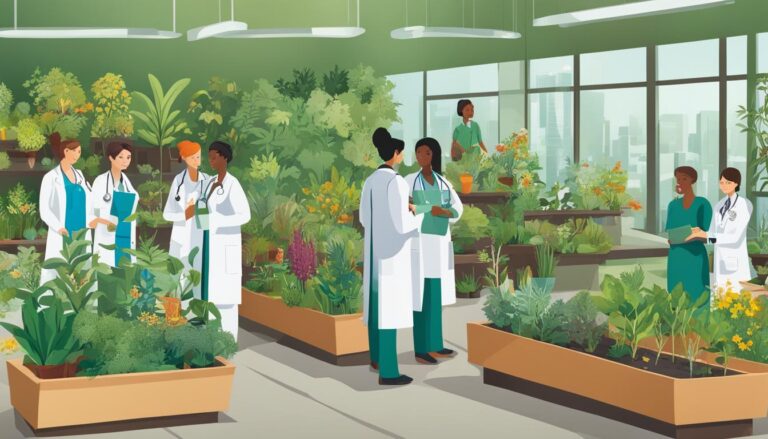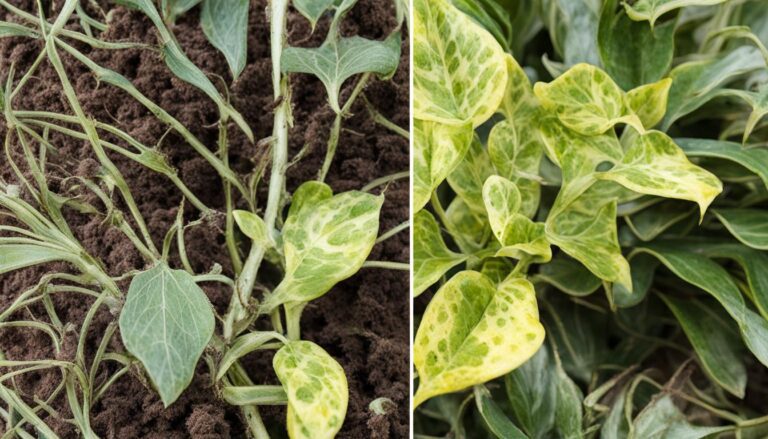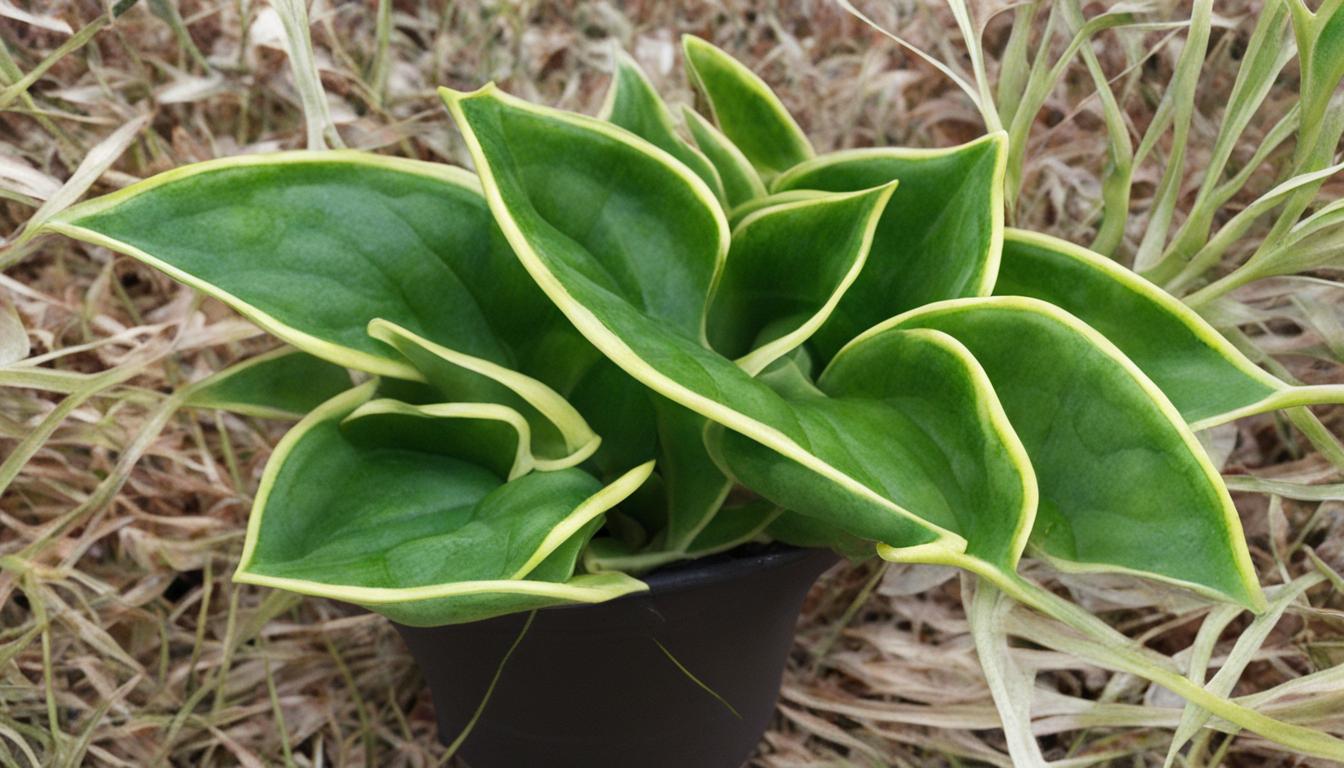
Greetings, fellow plant enthusiasts! Today, I am excited to delve into the fascinating topic of boron deficiency in plants and share valuable insights on how to recognize the signs. As a plant lover myself, I understand the importance of ensuring optimal health for our leafy friends.
Boron, a micronutrient, plays a crucial role in various plant functions, including protein synthesis, cell wall development, carbohydrate metabolism, and fruit set. However, when plants suffer from boron deficiency, it can lead to a range of symptoms that should be identified and addressed promptly.
The signs of boron deficiency typically manifest at the growing tips of roots or shoots. Keep an eye out for stunted growth, distorted growing tips, brittle foliage, and yellowing of lower leaf tips. Other indicators may include reduced flowering and fruiting, distorted fruit development, and soft brown centers in root crops.
It is vital to be aware that certain crops, such as broccoli, cabbage, and cauliflower, are particularly susceptible to boron deficiency. The occurrence of boron deficiency is more common in sandy soils with low organic matter content and in acidic or alkaline soil conditions.
To accurately diagnose boron deficiency, soil and tissue tests are valuable tools that can help determine the need for boron fertilizer application. Furthermore, it is essential to note that while boron deficiency can be detrimental to plants, over-application of boron can lead to toxicity, particularly in cole crops.
Key Takeaways:
- Identifying signs of boron deficiency in plants is crucial for maintaining their optimal health.
- Look out for stunted growth, distorted growing tips, brittle foliage, and yellowing of lower leaf tips.
- Reduced flowering and fruiting, distorted fruit development, and soft brown centers in root crops are also indicators of boron deficiency.
- Sandy soils with low organic matter content and acidic or alkaline soil conditions are more prone to boron deficiency.
- Soil and tissue tests can help determine the need for boron fertilizer application.
Importance of Boron for Plant Health
Boron plays a crucial role in maintaining the overall health and growth of plants. As a micronutrient, it is involved in various essential functions within plant cells, such as protein synthesis, cell wall development, carbohydrate metabolism, and fruit set.
Without sufficient boron levels, plants can exhibit a range of deficiency symptoms that negatively impact their growth and productivity.
Recognizing the indicators of boron deficiency in plants is key to effectively addressing the issue. Common signs include stunted growth, distorted growing tips, brittle foliage, yellowing of lower leaf tips, reduced flowering and fruiting, distorted fruit development, and soft brown centers in root crops. These symptoms are most noticeable in new plant tissue, such as young leaves and reproductive structures.
To maintain plant health, it is important to ensure an adequate supply of boron. Sandy soils with low organic matter content and acidic or alkaline soil conditions are more prone to boron deficiency.
Regular soil and tissue testing can help determine if boron fertilizer application is necessary. By proactively addressing boron deficiency and providing the necessary nutrients, plants can thrive and reach their full potential.
The Importance of Boron for Plant Health
| Boron Functions | Plant Effects |
|---|---|
| Maintains cell integrity | Prevents stunted growth and distorted leaf tips |
| Facilitates sugar movement | Supports growth and seed production |
| Supports nitrogen nodulation in legume crops | Enhances nitrogen fixation |
By understanding the importance of boron for plant health and recognizing the signs of deficiency, growers can take proactive measures to ensure their plants receive the necessary nutrients. Proper management of boron deficiency can lead to healthier and more productive plants.
Crops Prone to Boron Deficiency
As mentioned earlier, different crops have varying requirements for boron. It is essential to understand which crops are more prone to boron deficiency and the signs to look out for. This knowledge can help farmers and gardeners identify and address boron deficiency promptly, ensuring optimal plant growth and productivity.
Brassica crops, such as broccoli, cabbage, cauliflower, rutabaga, and turnips, have high boron requirements. These crops are particularly susceptible to boron deficiency, and signs may include stunted growth, distorted leaf tips, and reduced flowering.
Other crops like asparagus, carrots, cucurbits, eggplants, onions, strawberries, tomatoes, and potatoes have medium boron requirements. Peppers and sweet potatoes have low boron requirements, while beans and peas have very low boron requirements.
To effectively manage boron deficiency, it is crucial to be familiar with the boron needs of specific crops. This knowledge can help in identifying early signs of deficiency and implementing appropriate management practices.
By providing the necessary boron supplementation, farmers and gardeners can ensure healthy and thriving crops.
| Crop | Boron Requirement |
|---|---|
| Broccoli | High |
| Cabbage | High |
| Cauliflower | High |
| Rutabaga | High |
| Turnips | High |
| Asparagus | Medium |
| Carrots | Medium |
| Cucurbits | Medium |
| Eggplants | Medium |
| Onions | Medium |
| Strawberries | Medium |
| Tomatoes | Medium |
| Potatoes | Medium |
| Peppers | Low |
| Sweet Potatoes | Low |
| Beans | Very Low |
| Peas | Very Low |
Symptoms of Boron Deficiency in Plants
When it comes to boron deficiency in plants, there are several early warning signs that can help you identify the issue before it becomes severe. Recognizing these symptoms is crucial for implementing timely management practices to ensure the health and productivity of your plants.
One common symptom of boron deficiency is stunted growth. Plants lacking sufficient boron may exhibit slow and limited growth, especially in their roots and shoots.
You may also notice distorted growth of leaf tips, with leaves becoming curled or wrinkled. Another telltale sign is the appearance of hollow or rough stems, which can weaken the plant’s structure.
Additionally, boron deficiency often leads to discoloration of leaves. Chlorosis, or yellowing of leaf tips, is a common indicator, especially in the lower leaves of the plant.
Fading of growing tips may also occur, as well as other visual abnormalities such as brittle foliage. By paying attention to these early warning signs, you can take proactive measures to address boron deficiency and promote optimal plant growth.
Boron Deficiency Symptoms in Plants:
- Stunted growth
- Distorted growth of leaf tips
- Hollow or rough stems
- Leaf chlorosis, especially in lower leaves
- Fading of growing tips
- Brittle foliage
To visually illustrate the symptoms of boron deficiency, refer to the table below:
| Crop | Symptoms |
|---|---|
| Broccoli | Brittle stems, distorted florets |
| Cabbage | Hollow stems, curled or wrinkled leaves |
| Cauliflower | Poor curd development, distorted leaves |
| Strawberries | Slow growth, small pale fruits |
By being aware of these symptoms and using the provided table as a reference, you can quickly identify boron deficiency in your plants and take appropriate actions to address the issue. Early detection and management are key to maintaining the health and productivity of your crops.
Managing Boron Deficiency in Plants
Diagnosing and detecting boron deficiency in plants is essential to effectively manage and treat the condition. Soil and tissue testing play a crucial role in determining the need for boron fertilizer application.
Taking proactive measures before symptoms of deficiency appear is key, as it can be challenging to correct once plants are already deficient.
Soils deficient in boron can be amended with boron-containing fertilizers such as Borax, boric acid, and Solubor, based on soil tests and crop requirements.
Foliar applications of boron are recommended in high pH soils. Different cultivars may have varying susceptibilities to boron deficiency, so it’s important to consider crop-specific needs.
Soil and tissue testing can provide valuable information on the availability and uptake of boron by plants. By implementing appropriate application methods and considering factors such as soil pH, organic matter content, and moisture levels, farmers and gardeners can effectively manage boron deficiency in plants and promote optimal growth and development.
| Crop | Boron Requirement |
|---|---|
| Broccoli, cabbage, cauliflower, rutabaga, turnips | High |
| Asparagus, carrots, cucurbits, eggplants, onions, strawberries, tomatoes, potatoes | Medium |
| Peppers, sweet potatoes | Low |
| Beans, peas | Very low |
By understanding the crops prone to boron deficiency and implementing appropriate management practices, farmers and gardeners can ensure healthy and thriving plants.
Symptoms of Boron Deficiency in Different Crops
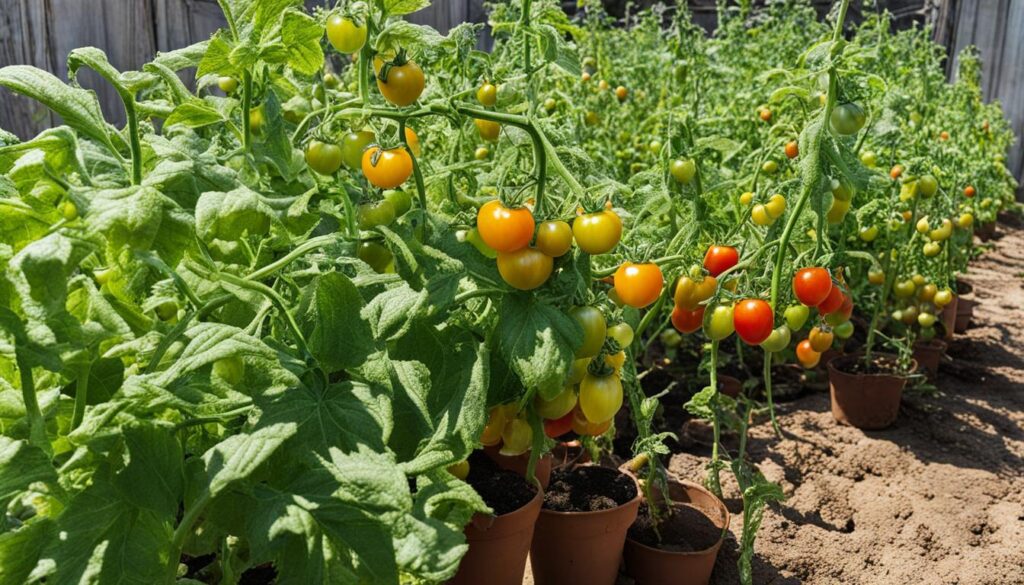
Recognizing the symptoms of boron deficiency in different crops is crucial for early detection and effective management. Here are some common symptoms observed in various crops:
Apples
- “Water core” in apples, which is the presence of watery, discolored, or corky areas in the fruit’s flesh.
Beetroot
- Rough and cankered patches on beetroot roots.
Cabbage
- Disrupted leaves and hollow stems in cabbage. The leaves may exhibit pale discoloration and stunted growth.
Cauliflower
- Poor curd development in cauliflower, characterized by small, loose, or misshapen heads.
Celery
- Cracked leaf stalks in celery, often accompanied by leaf yellowing and restricted growth.
Palm Tree Ferns
- Brown spots on palm tree ferns, which could be a sign of boron deficiency.
Strawberries
- Slow growth and small pale fruits in strawberries, along with abnormal leaf development.
These symptoms provide early warning signs of boron deficiency in various crops. By identifying these indicators, farmers and gardeners can take proactive measures to address the nutrient imbalance and ensure healthy plant growth.
| Crop | Symptoms |
|---|---|
| Apples | “Water core” in fruit flesh |
| Beetroot | Rough and cankered patches on roots |
| Cabbage | Disrupted leaves and hollow stems |
| Cauliflower | Poor curd development |
| Celery | Cracked leaf stalks |
| Palm Tree Ferns | Brown spots |
| Strawberries | Slow growth and small pale fruits |
Causes of Boron Deficiency in Plants
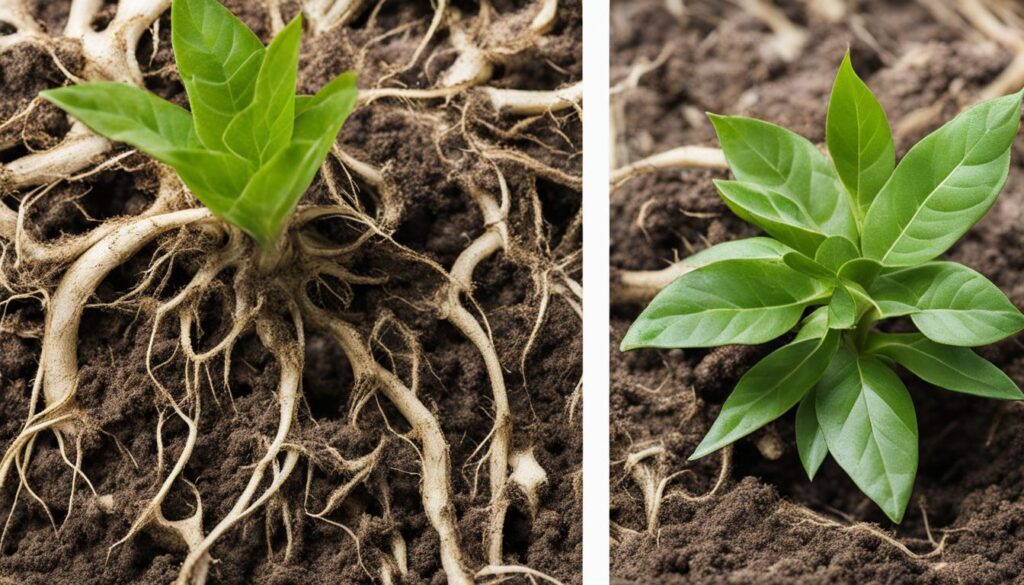
When it comes to diagnosing and detecting boron deficiency in plants, understanding the causes is crucial. Boron uptake by plant roots relies on the active movement of water, so deficiency can occur when there is insufficient water movement in the plant.
Deficient boron in fertilizer or tap water, dry or wet soil conditions, high humidity, high pH levels, high calcium levels, densely packed soil, cold root growth areas, and inactive roots can all contribute to boron deficiency in plants.
Insufficient water movement in the plant, whether due to inadequate irrigation or waterlogged conditions, can limit the availability of boron for uptake. This can lead to boron deficiency symptoms in plants, such as stunted growth and chlorosis.
Similarly, soil factors like high pH levels, high calcium content, and densely packed soil can restrict boron availability, making it difficult for plants to acquire sufficient boron for their needs.
Other factors that contribute to boron deficiency include cold root growth areas, which can impede nutrient uptake, and inactive roots, which may fail to effectively absorb boron from the soil.
It is also important to consider the source of boron, as deficient boron in fertilizer or tap water can lead to inadequate levels of this micronutrient in plants. By understanding these causes of boron deficiency, growers can implement appropriate management strategies to prevent and address this issue.
Table: Causes of Boron Deficiency in Plants
| Causes | Description |
|---|---|
| Insufficient water movement in the plant | Lack of irrigation or waterlogged conditions can limit boron availability |
| Deficient boron in fertilizer or tap water | Inadequate boron levels in these sources can lead to deficiency symptoms |
| Dry or wet soil conditions | Extreme moisture conditions can affect boron uptake and availability |
| High humidity | Elevated humidity levels can contribute to boron deficiency |
| High pH levels | Alkaline soil can limit boron availability for plants |
| High calcium levels | Excessive calcium can interfere with boron uptake and utilization |
| Densely packed soil | Compacted soil can restrict root growth and nutrient uptake |
| Cold root growth areas | Low temperatures can hinder nutrient absorption by roots |
| Inactive roots | Inactive or damaged roots may struggle to take up boron |
Treatment and Recovery from Boron Deficiency
When diagnosing and detecting boron deficiency in plants, it is essential to implement effective treatment and recovery strategies. The first step is to address any underlying stressful conditions that may have contributed to the deficiency.
This can include regulating the pH of the growing medium to maintain levels around 6.0 to 6.5, ensuring proper water supply, and providing moisture through the use of humidifiers in grow rooms.
One of the key approaches to treating boron deficiency is to use boron-containing soil amendments. These can include products such as Borax, boric acid, or Solubor, depending on the specific needs of your soil and crop.
It is crucial to apply these amendments before symptoms of deficiency appear, as it can be challenging to correct the deficiency once plants are already affected.
Monitoring the appearance of new growth is also important when recovering from boron deficiency. If the damage is not severe, plants can usually recover within a few days of implementing appropriate treatments and ensuring optimal growing conditions.
By addressing the deficiency and providing the necessary nutrients, plants can regain their health and vitality.
Remember, boron deficiency can have different symptoms in different crops, so it is important to recognize the specific signs of deficiency in your plants.
By promptly diagnosing and treating boron deficiency, you can ensure the continued growth and productivity of your plants.
FAQ
How can I recognize boron deficiency in plants?
Some common signs of boron deficiency in plants include stunted growth, distorted growing tips, brittle foliage, yellowing of lower leaf tips, reduced flowering and fruiting, distorted fruit development, and soft brown centers in root crops.
Which crops are more prone to boron deficiency?
Brassica crops like broccoli, cabbage, and cauliflower have high boron requirements and are particularly susceptible to boron deficiency. Other crops with medium boron requirements include asparagus, carrots, cucurbits, eggplants, onions, strawberries, tomatoes, and potatoes.
What are the conditions that favor boron deficiency in plants?
Boron deficiency occurs most frequently in sandy soils with low organic matter content and in acidic or alkaline soil. It is also more likely to occur in dry or wet soil conditions, high humidity, high pH levels, high calcium levels, densely packed soil, cold root growth areas, and inactive roots.
How can I manage boron deficiency in plants?
Soil and tissue tests can help determine the need for boron fertilizer application. Amendments with boron-containing fertilizers like Borax, boric acid, and Solubor can be made based on soil tests and crop requirements. Foliar applications of boron are recommended in high pH soils. It is important to apply boron before symptoms of deficiency appear.
What are the symptoms of boron deficiency in different crops?
Symptoms of boron deficiency can vary across crop species. Some examples include “water core” in apples, rough and cankered patches on beetroot roots, disrupted leaves and hollow stems in cabbage, poor curd development in cauliflower, cracked leaf stalks in celery, brown spots on palm tree ferns, and slow growth and small pale fruits in strawberries.
What are the causes of boron deficiency in plants?
Causes of boron deficiency include deficient boron in fertilizer or tap water, dry or wet soil conditions, high humidity, high pH levels, high calcium levels, densely packed soil, cold root growth areas, and inactive roots.
How can boron deficiency in plants be treated and recovered from?
Treating boron deficiency involves resolving stressful conditions, using boron-containing soil amendments, regulating the pH of the growing medium, ensuring adequate water supply, providing moisture through humidifiers in grow rooms, and monitoring the appearance of new growth. Soil pH levels should be maintained around 6.0 to 6.5 for optimal boron absorption. Plants can recover from boron deficiency within a few days if the damage is not severe and appropriate treatments are implemented.


